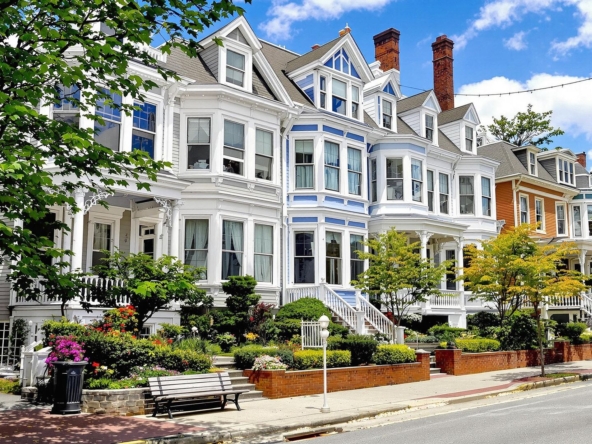Thinking about buying or selling a home in Tampa next year? The tampa housing market is always changing, and 2025 looks to be no different. We’ve put together some thoughts on what to expect, looking at what’s driving prices, what kinds of homes are popular, and what might happen with interest rates. It’s a lot to keep track of, but hopefully, this helps you get a clearer picture of the tampa housing market.
Key Takeaways
- Economic factors and population growth are major influences on the tampa housing market.
- Expect continued interest in single-family homes, but condos and townhouses are also worth watching.
- Interest rates and the number of homes available will play a big role in how easy it is to buy or sell.
- Some Tampa neighborhoods are becoming more popular for investment, while others offer good value.
- Buyers should be ready for a competitive market, and sellers need a good plan to get the best price.
Understanding Tampa Housing Market Dynamics
Let’s get a handle on what’s really going on with Tampa’s housing market. It’s not just about pretty houses; there are bigger forces at play that shape everything from prices to what kind of homes people are looking for.
Key Economic Indicators Influencing Tampa Real Estate
When we talk about the economy, we’re really talking about the health of the Tampa Bay area. Things like how many people have jobs, how much money they’re making, and what it costs to live here all play a part. For instance, if more people have steady work and their paychecks are growing, they’re more likely to buy a home or even upgrade. We’re seeing a decent job growth here, which is good news for the housing market. A strong local economy generally means more demand for housing. It’s also worth keeping an eye on inflation and interest rates, as those directly affect how much people can afford to borrow for a mortgage. Many homeowners are in a good spot equity-wise, with over 46% of mortgaged homes being equity-rich in early 2025, according to Attom’s report. This can give people more options when it comes to selling or buying their next place.
Population Growth and Its Impact on Demand
Tampa has been a magnet for people, and that doesn’t seem to be slowing down much. More people moving in means more people need a place to live, whether they’re renting or buying. This increased demand puts pressure on the existing housing supply. Think about it: if 100 new people move to town each week and there are only 50 new homes built, prices are bound to go up, right? This influx affects all types of housing, from starter condos to larger family homes. It’s a pretty straightforward supply and demand situation, and Tampa’s growth is definitely a big factor.
Job Market Trends Shaping Housing Needs
The types of jobs available in Tampa also influence what kind of homes people need. Are we seeing a boom in tech jobs that might mean more demand for modern apartments or townhouses in urban centers? Or is it more about service industry growth that could lead to more demand for single-family homes in the suburbs? The job market here is pretty diverse, with strengths in healthcare, finance, and tourism. This variety means different housing needs are being met across the region. For example, a growing tech sector might attract younger professionals who prefer city living, while expanding healthcare facilities could draw families looking for homes closer to work. Understanding these job trends helps us predict where and what kind of housing will be most sought after. You can check out some of the latest job openings in the area at Tampa Bay jobs.
The interplay between economic health, population shifts, and job market evolution creates a complex but understandable picture of Tampa’s housing landscape. Each element influences the others, creating a dynamic environment for anyone involved in real estate.
Residential Property Trends in Tampa Bay

When we look at Tampa Bay’s housing scene, it’s not just one big picture. Different types of homes are doing their own thing, and it’s pretty interesting to see how it all shakes out. The single-family home market continues to be the backbone of Tampa’s residential real estate. But condos and townhouses are definitely carving out their own space, especially for folks looking for a more urban lifestyle or perhaps a second home.
Single-Family Home Market Analysis
For single-family homes, we’re seeing steady demand, particularly in areas that offer good schools and convenient commutes. Buyers are still very much interested in these properties, but affordability is a big question mark for many. We’ve noticed a trend where buyers are willing to look a bit further out from the city center to find homes that fit their budget. This has led to some growth in surrounding counties.
Condominium and Townhouse Market Outlook
Condos and townhouses are becoming more attractive, especially for younger professionals and empty nesters. These properties often come with lower maintenance and access to amenities, which is a big plus. The downtown and waterfront areas are seeing a lot of activity in this segment. It’s a good option for those who want to be closer to the action, maybe even near places like St. Pete’s waterfront.
Rental Market Performance and Projections
The rental market in Tampa Bay remains strong. With a growing population and a job market that keeps attracting new residents, there’s consistent demand for rental properties. We’re seeing rent prices stabilize a bit after some rapid increases, but overall, it’s still a landlord’s market in many areas. Investors are keeping a close eye on this, as rental yields can be quite good.
The mix of new construction and existing homes means buyers have choices, but understanding the specific dynamics of each property type is key to making a smart move in Tampa Bay.
Factors Driving Tampa Housing Market Activity
So, what’s actually making the Tampa housing market tick in 2025? It’s not just one thing, but a mix of economic forces and practical considerations that buyers and sellers are dealing with every day. Interest rates, for instance, continue to play a big role in how much people can afford. When rates go up, monthly payments jump, which can cool down buyer enthusiasm pretty quickly. Conversely, if rates dip, more people might feel comfortable taking the plunge.
Interest Rate Environment and Mortgage Affordability
We’ve seen some back-and-forth with interest rates lately. It’s made budgeting for a home a bit of a guessing game for many. If you’re looking to buy, understanding your borrowing power is key. It’s worth talking to a mortgage broker to get a clear picture of what you can handle month-to-month, especially considering property taxes and insurance which are also part of the overall cost of owning a home in Tampa. Checking out current mortgage rates can give you a good idea of where things stand.
Inventory Levels and Supply Chain Considerations
Another big piece of the puzzle is how many homes are actually available. For a while now, inventory has been tight in many areas, meaning more buyers are chasing fewer homes. This can drive prices up. While construction is ongoing, supply chain issues can still slow things down, affecting how quickly new homes get built and listed. This imbalance between supply and demand is a constant factor.
Investor Sentiment and Foreign Investment
Investors, both local and from abroad, also have an impact. When investors see Tampa as a good place to put their money, they buy up properties, which can reduce the number of homes available for owner-occupiers. Foreign investment can add another layer, especially in certain high-demand areas. Their decisions are often based on broader economic trends and perceived stability, but they definitely influence the local market dynamics.
The interplay of these factors creates a complex environment. What might seem like a small change in one area can have ripple effects across the entire market, influencing everything from sale prices to how long a house stays on the market.
Neighborhood Spotlights and Local Market Insights
When you’re looking at Tampa real estate, it’s not just about the big picture; the specific neighborhoods really matter. Some areas are really taking off, while others are more stable. It’s good to know what’s happening on the ground level.
Emerging Neighborhoods for Investment
There are a few spots that are getting a lot of attention from people looking to invest. These areas often have lower entry prices but show promise for future growth. Think about places that are getting new infrastructure or have a growing number of young families moving in. For example, areas just outside the immediate downtown core are seeing a lot of redevelopment. This can be a great time to get in before prices really climb.
Established Areas Experiencing Growth
Of course, some of the more well-known neighborhoods are still doing great. These places usually have good schools, amenities, and a strong sense of community. They might not offer the same kind of rapid appreciation as emerging areas, but they tend to be more stable. You’ll find that demand remains high in these established communities, keeping property values steady. It’s worth checking out areas like South Tampa, which consistently attract buyers.
Affordability Challenges and Opportunities
Let’s be real, affordability is a big topic in Tampa right now. Some of the most desirable areas are becoming quite expensive, making it tough for first-time buyers. However, this also creates opportunities. As prices rise in prime locations, buyers might look to slightly more distant but still accessible neighborhoods. This can lead to increased demand and potential growth in those secondary markets. We’re seeing a median selling price for homes in Tampa around $437,000, which is a significant figure to consider when budgeting for a purchase. Finding a good deal often means looking a bit further out or being flexible on certain features. It’s a balancing act, for sure. You might find that a slightly smaller home in a great location is a better fit than a larger one further away. The key is to research different areas and understand the trade-offs. Exploring options outside the immediate city center could lead to finding great deals that fit your budget.
The housing market is always changing, and what’s hot one year might not be the next. Keeping an eye on local development projects and community changes can give you a heads-up on where to focus your attention. It’s about being informed and making smart choices based on current trends and future potential.
Predictions for the Tampa Housing Market in 2025

So, what’s the crystal ball telling us about Tampa’s housing scene next year? It’s looking like a pretty active year, with a few key things to keep an eye on. We’re expecting continued, albeit more moderate, home price appreciation across the board. It’s not going to be the wild ride of a few years back, but steady growth is definitely on the table. This is good news for homeowners looking to build equity, and for buyers, it means getting in now is still a smart move before prices climb too much higher.
Projected Home Price Appreciation
When we talk about price increases, it’s not going to be uniform. Some areas will see more action than others. Think about neighborhoods that are getting a lot of attention for new businesses or infrastructure projects; those are likely to lead the pack. We’re looking at a potential average appreciation of around 4-6% for single-family homes, with condos and townhouses possibly seeing a bit less, maybe in the 3-5% range. It’s important to remember these are averages, and local factors play a huge role. For instance, areas with good schools and amenities tend to hold their value better and see more consistent growth. It’s always a good idea to check out specific neighborhood data if you’re thinking of buying or selling. The overall economic health of the region, including job growth and interest rates, will also be a big influence on these numbers. If you’re curious about specific market data, looking at resources that track Tampa real estate trends can be really helpful.
Sales Volume Forecasts
Sales volume is projected to remain strong, though perhaps not at the record-breaking pace of recent years. We anticipate a healthy number of transactions, driven by ongoing demand from people moving to the area and existing residents looking to upgrade or downsize. A slight increase in inventory might help smooth out some of the buyer competition we’ve seen. Expect more balanced negotiations between buyers and sellers compared to the intense bidding wars of the past. This could mean more opportunities for buyers to get their offers accepted without having to waive every contingency. Sellers will still need to price their homes competitively and present them well to attract buyers, but the market should feel a bit more manageable.
Rental Yield Expectations
For investors, rental yields are expected to be stable, with potential for modest increases. As home prices continue to rise, more people may find themselves renting for longer, which keeps demand for rental properties high. We could see average rental rates increase by about 3-5%, depending on the property type and location. Areas with a strong renter base, like those near universities or major employment centers, are likely to perform best. It’s also worth noting that property management costs and insurance premiums could impact net yields, so it’s important to factor those into any investment calculations. Keeping an eye on vacancy rates will also be key; low vacancy rates generally mean stronger rental income potential.
Navigating Your Real Estate Journey in Tampa
So, you’re thinking about buying or selling a place in Tampa this year? It can feel like a lot, especially with all the talk about market shifts. But honestly, it’s totally doable if you break it down. Knowing what’s happening with prices and what buyers are looking for really helps.
Tips for Buyers in a Competitive Market
If you’re on the hunt for a home, getting pre-approved for a mortgage is step one. It shows sellers you’re serious and know what you can afford. Also, be ready to act fast when you find a place you like. The market has seen a big jump in active listings, with over 4,800 in June 2025 alone, which is good news for buyers looking for more options. Still, good homes go quickly.
- Get Pre-Approved: Talk to a lender before you start looking.
- Be Ready to Move: Have your finances in order and be prepared to make an offer.
- Know Your Must-Haves: Decide what you absolutely need versus what’s nice to have.
- Explore Different Areas: Don’t limit yourself to just one neighborhood; Tampa has many areas with different vibes and price points.
Sometimes, you might need to compromise a little on your wish list to get into the market. It’s about finding that balance between what you want and what’s realistic right now.
Strategies for Sellers to Maximize Returns
For those looking to sell, presentation is key. A fresh coat of paint, decluttering, and maybe some minor repairs can make a big difference. Pricing your home correctly from the start is also super important. Overpricing can scare buyers away, while underpricing leaves money on the table. You can check out current market conditions and recent sales to get a good idea of value. It’s a good time to see what’s happening with Tampa housing market dynamics.
- Stage Your Home: Make it look inviting and spacious.
- Price it Right: Research comparable sales in your area.
- High-Quality Photos: Good pictures attract more attention online.
- Be Flexible with Showings: Make it easy for potential buyers to see your home.
The Role of Real Estate Professionals
Working with a real estate agent can really smooth out the process. They have the local knowledge, understand the paperwork, and can help you negotiate. Whether you’re buying or selling, a good agent is like having a guide who knows the shortcuts and potential pitfalls. They can help you understand the nuances of specific neighborhoods and what buyers are really looking for in today’s market.
Looking Ahead: Your Tampa Housing Guide
So, what does all this mean for folks looking to buy or sell in Tampa next year? It seems like things will stay pretty active. Prices might not shoot up like they have been, but they probably won’t drop much either. If you’re thinking about moving, getting your finances in order early is a good idea. And if you’re selling, making sure your place looks its best will still be important. The market can be tricky, but with a little planning, you can find your way. It’s always smart to talk to a local real estate agent who knows the Tampa area well. They can give you the most up-to-date advice for your specific situation. Good luck out there!
Frequently Asked Questions
What makes house prices go up or down in Tampa?
Think about how much money people are making and the cost of things. When the economy is doing well, more people have jobs and money to spend, which usually means more people want to buy houses.
How does having more people in Tampa affect the housing market?
More people moving to Tampa means more people need a place to live. This higher demand can push house prices up, especially if there aren’t enough houses available.
How do loan interest rates impact buying a home?
If interest rates on loans for houses are low, it’s cheaper to borrow money. This makes buying a house more affordable for more people, which can lead to more sales.
What happens if there aren’t many houses for sale?
When there are very few houses for sale, it’s like a bidding war – many people want the same few houses. This can make prices go up quickly.
Are there any specific areas in Tampa that are becoming popular for buying houses?
Some neighborhoods are becoming more popular because they are getting better or have good job opportunities nearby. These areas might see more people wanting to buy homes.
What are some good tips for buying or selling a house in Tampa?
For buyers, it’s smart to get your loan approval ready early and be prepared to act fast. For sellers, making sure your house looks its best and pricing it right can help you sell it quickly for a good price.




